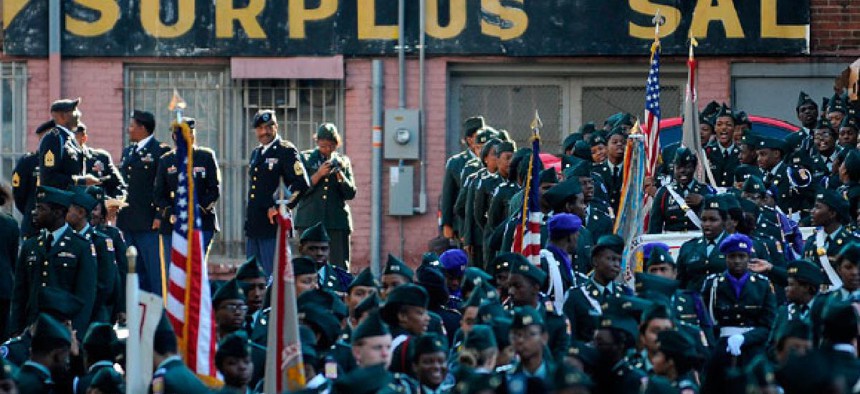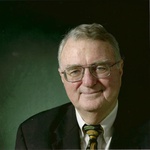
Participants in Atlanta's 31st annual Veterans Day Parade wait for the parade to begin. David Tulis/AP
Analysis: From war to work
Tailoring career transition programs to a new generation of veterans.
On Veteran’s Day, Americans should pause not only to remember the sacrifices of those who served in the armed forces years ago, but also to reflect on the men and women who deployed to Afghanistan and Iraq. The stereotypes about these veterans that have emerged are as limiting as those that surrounded my generation of veterans in the Vietnam era.
“Although there are some members coming back with [post-traumatic stress disorder], they are not the majority,” Holly Petraeus, assistant director for Servicemember Affairs for the Consumer Financial Protection Bureau said at a recent panel discussion in Washington. Petraeus, who also is the wife of retired general and former CIA director David Petraeus, warned that stigmatizing service members and veterans complicates their attempts to find employment as they re-enter civilian life.
In the late 1960s and ’70s, perceptions of drug addiction and psychological problems complicated civilian life for Vietnam veterans -- many of whom were draftees. Project 100,000, a 1960s Defense Department initiative, lowered recruiting standards to fill the military ranks and, ironically, to fight the war on poverty. Many of those recruits left the military with less-than-honorable discharges. Employers paid close attention to military records because the draft took in huge swaths of the male population between 18 and 25 years old. I was fortunate to have an honorable discharge as well as a master’s degree, and was able to move swiftly into a job that I loved.
Now about 1 percent of the population serves in the armed forces -- all volunteers. The paramount challenges for today’s veterans are landing meaningful jobs and climbing out of crushing debt. About 80 percent of these volunteers serve only one tour in the armed forces and quickly find themselves thrust back into civilian life without retirement benefits, jobs or work experience.
Holly Petraeus said many financial problems plague those in uniform and those who have left military service. She cited student loan debts, predatory practices of for-profit schools, payday loans with high interest rates and underwater home mortgages compounded by moves to new duty stations.
Petraeus noted federal efforts to provide mortgage relief and expose predatory practices, but the most pressing issue for this generation of veterans, especially those younger than 25, is jobs. October’s jobless report showed the unemployment rate for Afghanistan and Iraq vets rose to 10 percent compared with 9.7 percent in September. That translates to 290,000 young men and women looking for work.
Corporations and institutions that are trying to cut through the employment thicket should be applauded. General Electric, Home Depot and their partners in the Get Skills to Work program come to mind, as does Syracuse University’s pioneering Institute for Veterans and Military Families.
The U.S. Chamber of Commerce leads the way in trying to place veterans in good jobs. A variety of factors affect the employment rate of young veterans, according to Kevin Schmiegel, a retired Marine Corps officer and executive director of the chamber’s Hiring Our Heroes program. The unemployment rate for vets younger than 25 discharged in 2011 was 29.1 percent. Many of them have never been in the full-time job market, some might be taking time off before seriously looking for work and others might be waiting for school to begin.
The chamber’s goal this year is to host 400 job fairs in partnership with private and public sector organizations that will lead to the hiring of 500,000 veterans and their spouses by the end of 2014.
“Many of our members said they wanted to hire veterans,” Schmiegel says, but didn’t know how to go about it. “We had to step up,” he adds. Of 300 job fairs held so far, 10,000 veterans and spouses have been hired. The chamber tracks employment related to the fairs for up to a year because the hiring process can be slow at places like the federal government.
Zeroing in on younger job seekers, upcoming fairs will offer transition workshops to help them develop “90-second elevator speeches” to sell themselves to prospective employers, take advantage of social media and use the chamber’s Fast Track program to find out what kind of jobs are available and where. “I really do believe Fast Track is a game-changer” in moving veterans into satisfying careers, Schmiegel says.
The Defense and Veterans Affairs departments, along with the Labor Department and the Small Business Administration, are rethinking transition assistance for veterans of all ages. Defense rolled out a pilot called Transition Goals, Plan, Success, or Transition GPS, this summer.
Susan Kelly, principal director of the Pentagon’s Transition to Veterans Program Office, says the program will be fully implemented by the end of 2014. Gone are the PowerPoint slides and mind-numbing lectures to groups of several hundred service members about to leave active duty. The key, Kelly says, is to start from the point service members reach their first duty station. As they track their military career goals at promotion points, deployment and demobilization, they also set and track goals for when they leave the service. “This is a cultural change for the military,” she says.
For now, VA programs are off the table for immediate cuts, but how veterans programs at other agencies, such as SBA and the Education Department, will fare even if sequestration is avoided is an open question -- especially for younger veterans.
That troubles Linda Bilmes, senior lecturer in public policy at Harvard University’s John F. Kennedy School of Government. In one of her studies, her students -- many of them veterans -- found that funding was “disproportionately going to veterans who were falling through the cracks” or to older veterans.
The money and attention need to be applied to this generation of vets first to get them on their feet financially, educationally and occupationally. That was done successfully after World War II but not so well after Korea, Vietnam and Desert Shield/Desert Storm. The payoff for the country then was enormous. It can be again.
John Grady, retired director of communications for the Association of the United States Army, writes about defense and national security.







